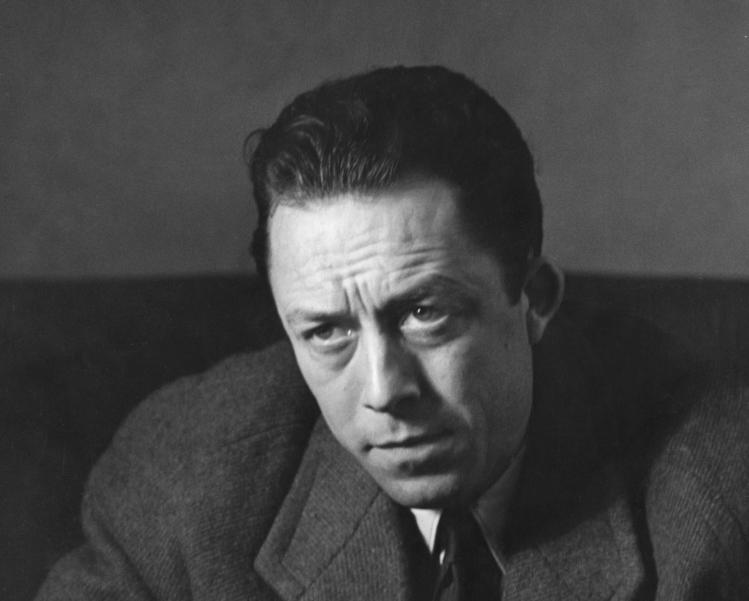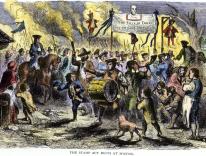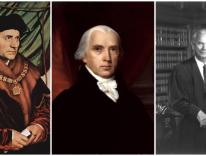
I first read Albert Camus when I was seventeen. I borrowed my father’s well-thumbed copy of The Stranger and greedily consumed it in one sitting on a train from Frederikssund to Copenhagen. I was spellbound. How could I not be? There in the novel was the bright Algerian sun and the shimmering Mediterranean Sea; outside my window was the drab Danish sky—the color of a pâté, forever portending rain. With every page I longed more intensely for the spare beauty of Algiers, to sense what Camus elsewhere describes as “a life that tastes of warm stone”—a life that, in the hard lyricism of his prose, seemed simple yet inexhaustibly rich. At the end of the novel, when the condemned Meursault is visited in his cell by the prison chaplain, he is asked if he ever wished for another life. He answers a little evasively. After the chaplain demands to know exactly how he pictured this other life, Meursault, finally, responds with a shout: “One where I could remember this life!”
Meursault’s moving outburst is also his maker’s. More than any other twentieth-century writer, Camus struggled to affirm life as it was handed to him, without appeal to religious or secular divinities. In his early notebooks, he spoke of wanting to “hold my life between my hands” and of enduring “this experience without flinching, with complete lucidity”—words made all the more poignant by the “sentence” of tuberculosis he received when he was just seventeen years old, and which repeatedly threatened to cut his life short. It was perhaps in Algiers’s Mustapha Hospital, in the winter of 1930, that Camus first felt himself brushed by the absurd: the clash between humankind’s desire for meaning and the inscrutable silence of the universe.
The young man who loved to roam the shabby streets of the Belcourt quarter, who preferred to spend his days swimming or playing soccer, thus learned early that our lives mean nothing to the mute world that surrounds us. Only a few years after receiving his diagnosis, Camus asked the costume designer and amateur pilot Marie Viton to fly him to Djemila, a coastal mountain village home to the ancient Roman ruins of Cuicul. There, standing atop the stony remnants of a vanished world, a hard wind burning his eyes and cracking his lips, Camus was overcome by the unrelenting indifference of the natural world. As he wrote in “The Wind at Djemila,” the essay his experience inspired:
I tell myself: I am going to die, but this means nothing, since I cannot manage to believe it and can only experience other people’s death. I have seen people die. Above all, I have seen dogs die. It was touching them that overwhelmed me. Then I think of flowers, smiles, the desire for women, and realize that my whole horror of death lies in my anxiety to live. I am jealous of those who will live and for whom flowers and the desire for women will have their full flesh and blood meaning. I am envious because I love life too much not to be selfish. What does eternity matter to me?
For the twenty-three-year-old author who wrote those words, death was not the distant terminus of old age but an awful negation that threatens at every moment to erase us. Remarkably, for someone so young when the shadow of death first darkened his way, he did not recoil from this insight. He had no interest in merely pacifying the terror of death, as the Stoic philosophers counseled. (In the Enchiridion, Epictetus recommends that we think of death daily, in order to lessen our fear of it.) Instead, Camus resolved to “gaze upon my death with the fullness of my jealousy and horror,” to face the absurdity of the human condition with total clarity. “I have no wish to lie or to be lied to,” he wrote.
Camus made his first notes for “The Wind at Djemila” around the same time he conceived of Meursault’s conversation with the prison chaplain. That proximity is telling. “Have you no hope at all? And do you really live with the thought that when you die, you die, and nothing remains?” the chaplain asks. When Meursault answers in the affirmative, the chaplain tells him it is more than a man can bear. Nevertheless, it is the wager Meursault is determined to make.
This wager was also Camus’. “I want to know whether I can live with what I know and with that alone,” he declared in The Myth of Sisyphus—the philosophical essay he wrote simultaneously with The Stranger, and which forms a kind of companion to it. Camus cannot know whether God exists, or whether the universe has a meaning that transcends it, but he knows that he cannot know these things. They are beyond human comprehension and therefore meaningless. “What can a meaning outside my condition mean to me?” All he knows is that the human need for reason cannot be reconciled with an unreasonable world. Having reached this limit, he decides to endure the absurd and live by that decision. “The mind, when it reaches its limits, must make a judgment and choose its conclusions.”
Camus’ atheism is attractive because it proceeds from a difficult acknowledgment of human limitations and vulnerability. It has none of the bluster of the nineteenth century’s positivistic atheism (repackaged, in this century, as “New Atheism,” despite not being very new at all) and therefore constitutes, as James Wood has shown, a “fierce exception” to the discourse of atheism. In fact, Camus was often accused, by critics on both the Left and the Right, of being a religious thinker in irreligious disguise. When he joined the Communist Party in the summer of 1935, he wasn’t reading Marx or Engels, but his beloved fellow Africans Augustine and Plotinus instead. He even wrote to his friend and classmate Claude de Fréminville criticizing the party’s “lack of religious emphasis, and the Marxists’ pretense of constructing a morality that depicts man as sufficient unto himself.”
In other words, far from thinking that religious belief is just superstitious nonsense, Camus understood that it satisfies a very real metaphysical need. Like Nietzsche, he recognized that the death of God is not a deliverance from dark superstition to rational light, but an absence that demands a secular response: “What interests me is knowing how we must behave, and more precisely, how to behave when one does not believe in God or reason.”
What is remarkable about Camus is not just how early in life he hit on the ideas he would eventually make his own, but the material impoverishment in which he did so. Growing up in the working-class Belcourt quarter of Algiers, he had none of the advantages of his French contemporaries and, unlike them, did not attend any of Paris’s elite educational institutions. In the shabby family apartment on Rue de Lyon, where he lived with his mother, brother, grandmother, and uncle, there was no electricity or running water. The only toilet was located on the landing and had to be shared with two other families. Bathing was done in the kitchen with water fetched from faucets in the street.
Yet what Camus lacked materially he was compensated for by the lavish physical impressions Algiers had to offer. “What other city offers as many riches all year long, the sea, the sun, hot sand, geraniums, and olive and eucalyptus trees?” he once asked a friend. In the essay “Summer,” first published in 1950, he wrote of his “instinctive fidelity to a light in which I was born, and in which for thousands of years men have learned to welcome life even in suffering.”
This world of sunlight and poverty, which held such vital importance for Camus, is sensuously evoked in his two youthful essay collections, The Wrong Side and the Right Side and Nuptials, published in Algiers in 1937 and 1939, respectively. Along with the much later collection Summer, published in France in 1954, these essays are now available again to English-language readers in a single volume titled Personal Writings, which joins a slimmer volume of Committed Writings, both edited by the Camus scholar Alice Kaplan. (A third volume, Conferences and Speeches, will be published next year.) While Committed Writings is something of a wasted opportunity (of the many “committed” writings Camus produced, only five are included here), Personal Writings offers a welcome return to what Kaplan, in her useful foreword, calls “the foundation for all his work to come.”
In the soil of almost every one of these early essays are the seeds of future work. Here are the origins of The Stranger: “Only on the day of the funeral, because of the general outburst of tears, did he weep, but he was afraid of being insincere and telling lies in the presence of death” (from “Irony”); The Myth of Sisyphus: “I can understand a man wanting to die because nothing matters anymore when one sees through life completely” (from “Between Yes and No”); and The Rebel: “I am surprised men can find certainties and rules for life on the shores of the Mediterranean, that they can satisfy their reason there and justify optimism and social responsibility” (from “Love of Life”).
Camus once defined the novel as “a philosophy expressed in images.” In these essays, we encounter a philosophy expressed through the senses. In “Between Yes and No,” the smell of a room “too long shut up” inspires a meditation on the difficulty of living. In “The Desert,” the view from the top of the Boboli gardens in Florence is a reminder that “the world is beautiful, and outside it there is no salvation.” In the best of these essays, “Nuptials at Tipasa,” a swim in the ocean arouses Camus to offer a defiantly sensual exaltation of life:
I love this life with abandon and wish to speak of it boldly: it makes me proud of my human condition. Yet people have often told me: there’s nothing to be proud of. Yes, there is: this sun, this sea, my heart leaping with youth, the salt taste of my body and this vast landscape in which tenderness and glory merge in blue and yellow. It is to conquer this that I need my strength and my resources. Everything here leaves me intact, I surrender nothing of myself, and don no mask: learning patiently and arduously how to live is enough for me, well worth all the arts of living.
The vast ocean, the arid desert, the brutal mountains—for Camus, to live in such immutable surroundings was to be confronted with the simple fact that human affairs are desperately precarious. This was an important lesson. It taught him what he would later call la mesure, or “measure”: a Mediterranean value of humility and limits illuminated by the blinding light of the sun. Writing in his notebook in 1942, he observed: “Calypso offers Ulysses a choice between immortality and the land of his birth. He rejects immortality. Therein lies perhaps the whole meaning of the Odyssey.” In Camus’ reading, Homer teaches us to embrace a life of limits, a life in which we are not yearning for either immortality or the afterlife. Our love for this earth is necessarily brief, and death is the price of admission, the final limit. Camus could not believe in God because to do so, as he put it in “Summer in Algiers,” is to “sin against life” by hoping for another, thus “evading the implacable grandeur of the one we have.”
In what would tragically turn out to be the last years of his life, Camus returned imaginatively to the landscape of his youth—a landscape that, because of the Algerian War, was not accessible to him in the way it once had been. In 1958, he agreed to a French edition of The Wrong Side and the Right Side, republished by Gallimard. The timing was significant. “I still live with the idea that my work has not even begun,” Camus wrote in his preface to the new edition. It was an odd claim for a writer who had just been given the Nobel Prize for Literature, but Camus was more troubled by the award than he was honored by it. Pained by the war in his native Algeria, shunned by Parisian intellectuals for his critique of the revolutionary Left, he feared he was finished as a writer—a fear that the Nobel Prize, which usually honors work done over a long career, only served to heighten. Refusing an interview with the newspaper L’Express, Camus explained that he wanted the noise and publicity surrounding the award to die away quickly. “I want to disappear for a while,” he said. To his friend Roger Quinox, he seemed “like someone buried alive.”
When at last he emerged from what he described as the twin torments of depression and writer’s block, Camus seemed cautiously poised to embark on a promising new path in his work—a descent inward that would finally allow him, he felt, to do justice to the silence and the sunlight that was his creative wellspring. “A man’s work is nothing but this slow trek to rediscover, through the detours of art, those two or three great and simple images in whose presence his heart first opened,” he wrote in 1958. The same year, he had begun work in earnest on The First Man, the beginning of what he hoped would become a long autobiographical novel in the style of Proust. In his notes, Camus stressed that it must be “heavy with objects and with physicality,” just as his early, lyrical essays had been. In a particularly evocative passage near the end of the surviving manuscript, Jacques Cormery, Camus’ novelistic stand-in, thinks of the “powerful, indescribable sensations” of the physical world around him and his “love of bodies,” a love that arouses in him “the longing, yes, to live, to live still more, to immerse himself in the greatest warmth this earth could give him.”
That longing was cut short on January 3, 1960, when Michel Gallimard’s Facel-Vega slid off the Nationale 5 road fifteen miles outside of Sens and slammed into a tree. Gallimard’s wife and daughter, sitting in the back, were unharmed, but Albert Camus, riding up front with Michel, was killed instantly. (Michel, too, later died of his injuries). The following day, Camus’ brother Lucien and his two daughters went to the family apartment on Rue de Lyon where the seventy-seven-year-old Catherine Camus still lived. When they informed her of her youngest son’s death, all she could say was, “Too young.”
He was too young, too loving of life, and surely had too much still to offer. But as William Faulkner wrote in his obituary of Camus, “When the door shut for him he had already written on this side of it that which every artist who also carries through life with him that one same foreknowledge and hatred of death, is hoping to do: I was here.” More than that, Camus left behind a body of work that appeals to those of us who are still here to be here, to accept our absurd condition with clarity and embrace the one perishable life we are given. In the “bright instant” he struck that tree, Faulkner observed, he was still “searching and demanding of himself.” For those of us still searching, he remains our demanding and indispensable guide.
Please email comments to [email protected] and join the conversation on our Facebook page.
Previous Story
Looking Down from the High Ground
Next Story
The Bundist Rabbi


